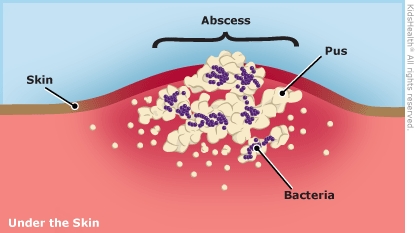A skin abscess is a collection of pus under the skin. The pus builds up as a reaction to germs (usually bacteria) that have gotten through a cut into the skin. Sometimes the pus drains out of the abscess through an opening in the skin.
Your child was seen in the emergency room (ER). If needed, the health care provider drained the abscess. They may have put gauze in the wound after they drained it. The abscess may continue to drain pus for the next few days. If needed, the health care provider prescribed antibiotics. You can care for your child at home while they heal.



Your child:

Red streaks begin to appear around the abscess.

How does an abscess form? When germs get into the skin through a cut, the body's immune system sends white blood cells to fight the germs. The white blood cells make pus, which gets trapped under the skin.
What types of germs lead to an abscess? The abscess is usually caused by a type of staph bacteria. Staph bacteria normally live on the skin and don't cause any problems. But if the bacteria get into the body through a cut in the skin, it can cause an infection. Staph aureus and MRSA (methicillin-resistant staph aureus) are the most common bacteria that cause abscesses.
Why is gauze sometimes put inside the abscess wound? The clean gauze keeps the wound from closing and allows the pus to keep draining. This is part of the healing process.
Does a child with an abscess always need an antibiotic? Some abscesses will get better on their own, so not all children need antibiotics. If your child needs an antibiotic, the health care provider will choose one that treats the specific bacteria.